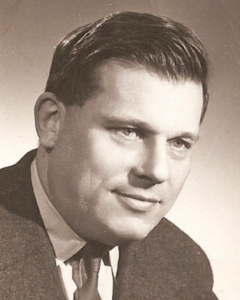István Barta
He began his higher education in 1928, and was a student at the technical universities of Vienna, Brno and Karlsruhe. He obtained his electrical engineering qualification in 1933 and his technical doctorate in 1934 at the Karlsruhe University of Technology.
From 1934 to 1938 he was a design engineer at Ericsson Hungarian Electricity Co.; then from 1938 he was employed by the United Incandescent Lamp and Electricity Co. (Tungsram), initially as a development engineer at the television research laboratory he founded; then from 1945 as head of the high-frequency department. He is credited with the development of radio tube production. He played a significant role in the Moon reflection experiments (1946) led by Zoltán Bay.
His educational and research activities were also significant. He participated in the founding of the State Technical College in 1947, which was the first telecommunications educational institution.
In 1948–1949, he was the technical director of the Orion Radio and Electricity Company, and then from 1949 to 1952, he was the department head of the Telecommunications Research Institute ( TKI ), whose founding organization he himself participated in.
In 1949, he was appointed to the Budapest University of Technology ( BME ), where he launched the university education of telecommunications in Hungary: he became the first head of the Department of Wireless Communications (from 1949 to 1972). In the meantime, he was the Dean of the Faculty of Electrical Engineering of BME between 1957 and 1960, and the Vice-Rector for Education of the university from 1960 to 1963. During this time, he also participated in the founding of the Department of Electronics Technology. Following the transfer of the Department of Communications, from 1972 until his retirement in December 1974, he directed the research work of the Institute of Communications and Electronics (HEI), newly formed from the merger of the departments of the Technical University, as its founding director.
During his work, he primarily dealt with the operating principles and electroacoustic aspects of radio and television receivers, electronic issues of color television, the development of amplifiers and electrical instruments, and problems of pulse technology. A unique area of his activities was the investigation of the human physiological and psychological effects of electroacoustic devices.
He is credited with writing numerous university textbooks and notes; lectures on radio reception technology, television technology, electron tubes, electronic measurements and pulse technology were based on his notes for decades.
In 1949, the Hungarian Academy of Sciences (MTA) elected him a corresponding member, and in 1976, a full member. In 1968, the Polish Academy of Sciences participated in the work of the Scientific Qualification Committee of the Hungarian Academy of Sciences, was the chairman of the electrotechnical group, and a member of the instrumentation and telecommunications committees. In 1949, he was one of the main organizers and founding members of the Telecommunication Scientific Association (HTE), whose activities he managed as chairman from 1953 to 1974, and after 1974 he was its honorary chairman. In addition, he also participated in the work of the presidency of the Association of Technical and Natural Science Associations (MTESZ). In 1968, he became an honorary member of the Polish Academy of Sciences.
He received the second degree of the Kossuth Prize (1957) for his textbook Radio Devices and Amplifiers, published in 1956. He was awarded the highest award in radio engineering, the Tivadar Puskás Prize, awarded by the Hungarian State Technical University twice (1960, 1975). He was also awarded the Excellent Worker Award (1948), the title of Excellent Worker of the Ministry of Education (1959) and the Order of Merit in Gold (1965, 1970).
- During the most difficult period of the dictatorship, he helped his colleagues, Professors Kozma and Simonyi, and others who were unjustly persecuted for political reasons.
- His bust was unveiled in November 2010 in the BME IT building.
Created: 2024.06.04. 14:41
Last modified: 2024.11.07. 13:14

